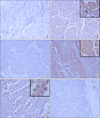Abstract
Background
Acyl protein thioesterase-1 (APT1) is a cytosolic protein that may function in the depalmitoylation of numerous proteins, including the Ras family. However, the clinical role of depalmitoyl thioesterase in human cancer is not known. We evaluated the APT1 expression in lung cancer tissue and its clinicopathological findings according APT1 expression pattern.
Methods
APT1 expression was examined by immunohistochemistry in the tumor tissue from 79 patients, who had undergone curative surgical removal of the primary lesion; all patients had been diagnosed with stage I non-small cell lung cancer between 1993 and 2004, at Gangnam Severance Hospital, Yonsei University College of Medicine, Seoul, Korea.
Results
The APT1 expression was seen in 50 out of 79 (63.3%) cases. The positive APT1 expression was significantly related with histologic subtype and T stage, but was not influenced by differentiation. The positive APT1 expression was not significantly related to patient age, gender, or smoking history. The median follow-up duration was 10.0 years; the 5-year survival rate was 71.0%. The positive APT1 expression group showed significantly worse overall survival and worse disease-free survival without statistical significance.
Figures and Tables
 | Figure 1APT1 expression in lung cancer tissues. An adenocarcinoma has no APT1 expression (A), whereas other has strong (B; inset, ×400). Also squamous cell carcinoma shows no expression (C) vs. strong expression (D; inset, ×400). Most of bronchioloalveolar carcinoma (E) and large cell carcinoma (F) has no APT1 expression (×200) (Immunohistochemistry). |
References
1. Jemal A, Siegel R, Ward E, Hao Y, Xu J, Thun MJ. Cancer statistics, 2009. CA Cancer J Clin. 2009. 59:225–249.
2. Subotic D, Mandaric D, Radosavljevic G, Stojsic J, Gajic M, Ercegovac M. Relapse in resected lung cancer revisited: does intensified follow up really matter? A prospective study. World J Surg Oncol. 2009. 7:87.
3. Wang A, Dennis EA. Mammalian lysophospholipases. Biochim Biophys Acta. 1999. 1439:1–16.
4. Baekkeskov S, Kanaani J. Palmitoylation cycles and regulation of protein function (Review). Mol Membr Biol. 2009. 26:42–54.
5. Sugimoto H, Hayashi H, Yamashita S. Purification, cDNA cloning, and regulation of lysophospholipase from rat liver. J Biol Chem. 1996. 271:7705–7711.
6. Molina JR, Adjei AA. The Ras/Raf/MAPK Pathway. J Thorac Oncol. 2006. 1:7–9.
7. Riely GJ, Marks J, Pao W. KRAS Mutations in non-small cell lung cancer. Proc Am Thorac Soc. 2009. 6:201–205.
8. Quatela SE, Philips MR. Ras signaling on the Golgi. Curr Opin Cell Biol. 2006. 18:162–167.
9. Chiu VK, Bivona T, Hach A, Sajous JB, Silletti J, Wiener H, et al. Ras signalling on the endoplasmic reticulum and the Golgi. Nat Cell Biol. 2002. 4:343–350.
10. Johnson L, Mercer K, Greenbaum D, Bronson RT, Crowley D, Tuveson DA, et al. Somatic activation of the K-ras oncogene causes early onset lung cancer in mice. Nature. 2001. 410:1111–1116.
11. Sakuma Y, Matsukuma S, Yoshihara M, Nakamura Y, Noda K, Nakayama H, et al. Distinctive evaluation of nonmucinous and mucinous subtypes of bronchioloalveolar carcinomas in EGFR and K-ras gene-mutation analyses for Japanese lung adenocarcinomas: confirmation of the correlations with histologic subtypes and gene mutations. Am J Clin Pathol. 2007. 128:100–108.
12. Marchetti A, Martella C, Felicioni L, Barassi F, Salvatore S, Chella A, et al. EGFR mutations in non-small-cell lung cancer: analysis of a large series of cases and development of a rapid and sensitive method for diagnostic screening with potential implications on pharmacologic treatment. J Clin Oncol. 2005. 23:857–865.




 ePub
ePub Citation
Citation Print
Print




 XML Download
XML Download